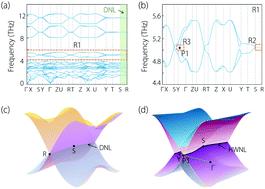Hourglass Weyl and Dirac nodal line phonons, and drumhead-like and torus phonon surface states in orthorhombic-type KCuS†
Abstract
In parallel to electronic systems, the concept of topology has been extended to phonons, which has led to the birth of topological phonons. In this Communication, based on symmetry analysis and first-principles calculations, we propose that hourglass Weyl nodal line (HWNL) phonons and Dirac nodal line (DNL) phonons coexist in the phonon dispersion of a single material, KCuS, with a Pnma-type structure. The HWNLs and DNLs are relatively flat in frequency and well separated from other phonon bands. The drumhead-like phonon surface state and the torus phonon surface state appear at the [001] and [100] surfaces, respectively. The reason for this phenomenon is explained based on the Zak phase calculations. The DNL and HWNL phonons are symmetry-related and these phonons can also be observed in other realistic materials, such as BaSi2, TiB and ZrSi, with a Pnma-type structure. Our Communication, for the first time, proves that phononic nodal lines with different types of degeneracies and different types of phonon surface states can be achieved in one single material. Thus, KCuS with a Pnma-type structure can be viewed as a good platform to investigate the entanglement between HWNL phonons and DNL phonons and to realize the drumhead-like and torus phonon surface states.

- This article is part of the themed collection: 2022 PCCP HOT Articles


 Please wait while we load your content...
Please wait while we load your content...